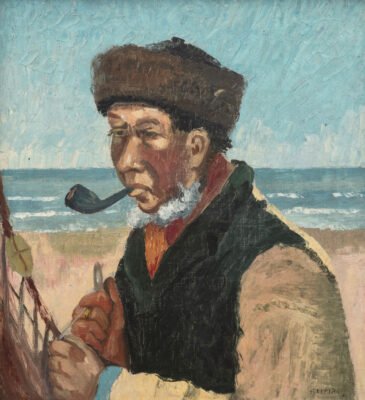For Harlem-born artist Tschabalala Self’s first solo exhibition in Finland – on show at the Espoo Museum of Modern Art (EMMA) until May 2025 – she pays homage to her birthplace, assembling and staging a convocation of its inhabitants at ease with their surroundings. The title of the exhibition, ‘Around the Way’, is a Black-American colloquialism that signifies the distinctive characteristics or charms of one’s neighbourhood, evoking a sense of familiarity and belonging. It is from here that Self departs, abstracting the essence of her community in vibrant multi-dimensional vignettes.
‘Around the Way’ by Tschabalala Self
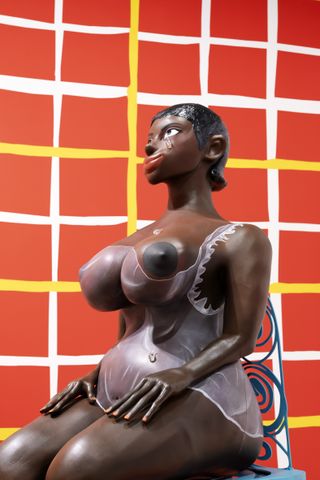
Tschabalala Self’s Negligee 1 (2023) at Espoo Museum of Modern Art (EMMA)
(Image credit: courtesy of Tschabalala Self Studio © Paula Virta/Espoo Museum of Modern Art)
The exhibition features nearly 20 works, including recent paintings, life-size sculptures, and three newly commissioned pieces that naturally evolve from the expressive, pluralistic practice that Self is recognised for.
Initially a painting student with an interest in printmaking, she uses fabric in a similar way to collagraph plates to build pictorial space through layers of materiality on the canvas. Her vibrant patchwork tableaux honour a lineage of Black American women such as the Gee’s Bend quilt collective, Faith Ringgold and Dindga McCannon, who similarly worked with textiles in this painterly manner. (Self has previously translated motifs from her painting into footwear and clothing with Ugg.)
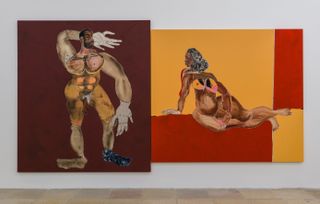
Tschabalala Self’s Dreamers (2021) at Espoo Museum of Modern Art
(Image credit: courtesy the artist, Pilar Corrias, London, and Galerie Eva Presenhuber, Zurich/Vienna. Image © Pierre Le Hors)
The shared experiences and encounters of Self’s Harlem take place across three sites within the exhibition. The first, the public sphere, exists as the street view. Here we encounter the large-scale triptych 12pm on 145th Street (2022), which takes its name from an intersection in Harlem and features a shadow-like figure striding across the canvas.
Mounted against a brick-patterned wall, the paintings in this space truly embody the sensation of being enveloped in the bustling cityscape and for Self, recall memories of walking through the neighbourhood with her older sister, stopping to speak to loved ones, friends, neighbours, and strangers.
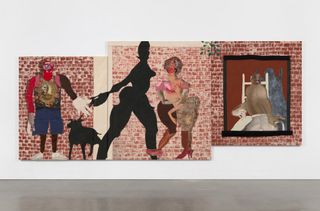
Tschabalala Self’s 12pm on 145th Street (2022) at Espoo Museum of Modern Art
(Image credit: courtesy the artist, Pilar Corrias, London, and Galerie Eva Presenhuber, Zurich/Vienna. Image: © Pierre Le Hors)
Entering the second gallery, the zone of interaction shifts to domestic scenes; lovers dance across chequerboard tiles, while an elderly man sits, watchful, with his hands folded in his lap. In Harlem Sphinx (2024), Self depicts a woman reclining in her pattern-clad boudoir, the view through the ornamentally welded bars stunted by brick.
‘Harlem Sphinx is an imagining of a woman in a typical Harlem brownstone,’ says Self. ‘The room is meant to look somewhat bourgeois, which is often the aspirational aesthetic of a brownstone, but directly outside her window is another building, so you know she’s in a densely populated metropolitan space like Harlem.’
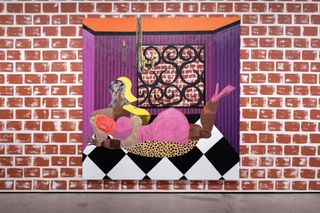
Tschabalala Self’s Harlem Sphinx (2024) at Espoo Museum of Modern Art
(Image credit: courtesy of Tschabalala Self Studio © Paula Virta/Espoo Museum of Modern Art)
The final setting of the exhibition isn’t necessarily a location but rather a state of mind. ‘It’s dealing with interiorities; a reflection of the feelings and interpersonal relationships occurring between characters that we’ve previously encountered in the street and the home,’ says Self. ‘I imagine the show as someone travelling deeper into knowing the community of characters depicted in my works.’
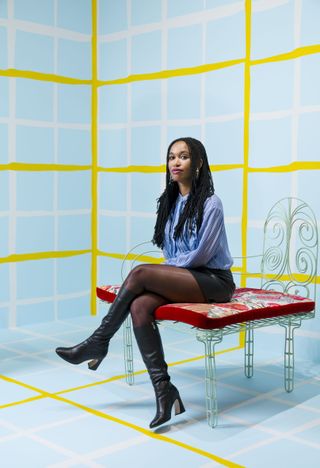
Tschabalala Self at Espoo Museum of Modern Art
(Image credit: © Paula Virta/Espoo Museum of Modern Art)
Speaking particularly to those scenes depicted beyond the public eye, such as Dreamers (2021) or Anthurium (2023), Self’s figures seem to possess a desire and authority to claim their space and determine how they are seen and understood.
Two figurative sculptures, titled Negligee 1 and Negligee 2 (2023), have been pulled directly from the artist’s 2019 painting Damsel. Their very presence in the three-dimensional space embodies the illusion of having entered a private sphere. ‘The sculptures serve to name the gallery space as that of the characters in the artworks,’ says Self. ‘Often it is felt that the subjects in an artwork are there for the edification of the viewer, but here that power and spatial dynamic has shifted, and the viewer is made to understand that they have the privilege of entering into the space of the subject.’
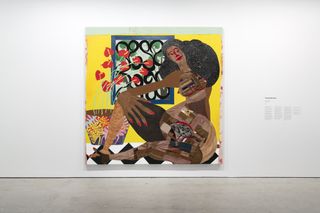
Tschabalala Self’s Anthurium (2023) at Espoo Museum of Modern Art
(Image credit: Saastamoinen Foundation Art Collection/Espoo Museum of Modern Art © Paula Virta/EMMA)
In ‘Around the Way’, the conflation of interior and exterior gestures towards the polysemy of home as both a physical and psychological locale. Self uses portraiture as a way in which to emphasise the body as a home for one’s consciousness, ambitions and fears.
‘I have always thought of home as the origin,’ she says. ‘A lot of these works are somewhat nostalgic, envisioned as memories of my neighbourhood [while I was] growing up that are perhaps not realistic depictions but more an attempt to capture the feeling of my birthplace.’
Tschabalala Self’s ‘Around the Way’ is at the Espoo Museum of Modern Art (EMMA) until 5 May 2025
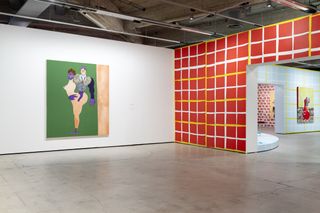
Installation view of Tschabalala Self’s ‘Around the Way’ at Espoo Museum of Modern Art
(Image credit: © Paula Virta/Espoo Museum of Modern Art)
